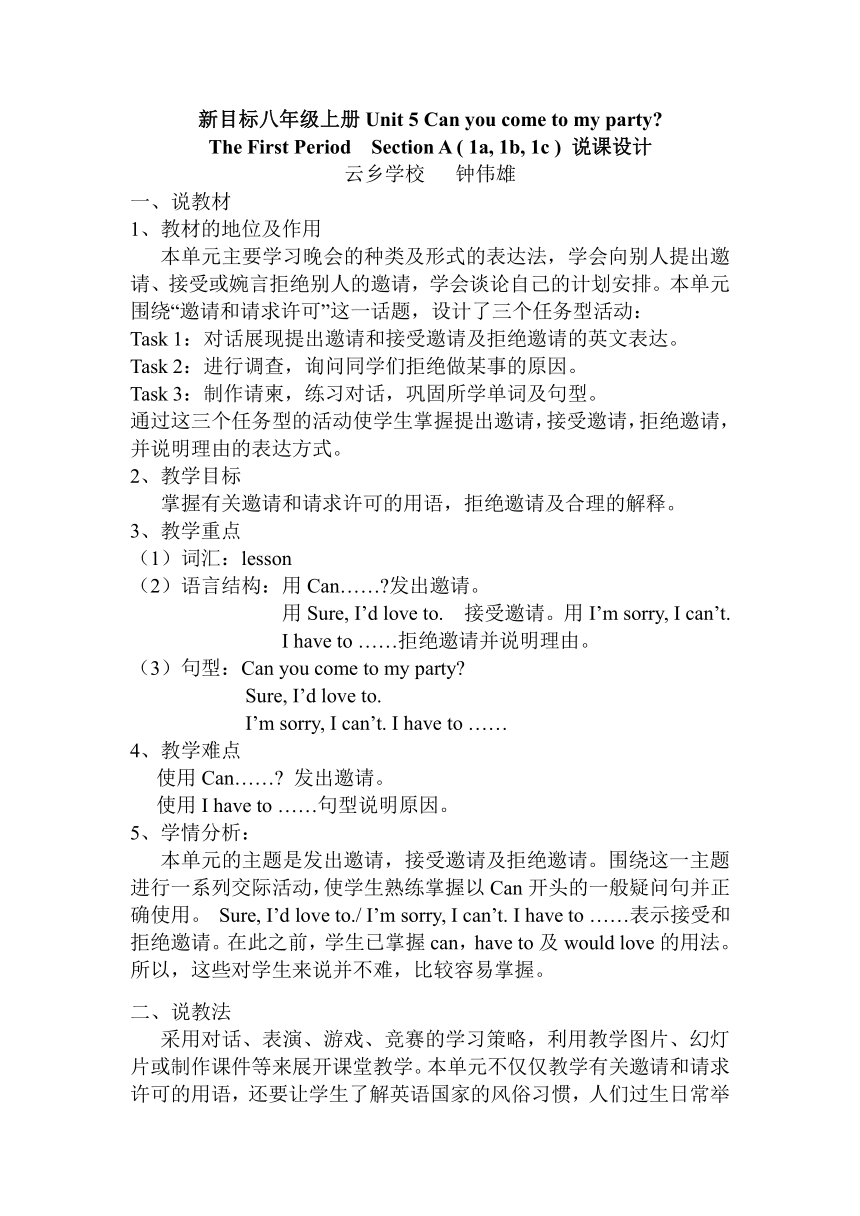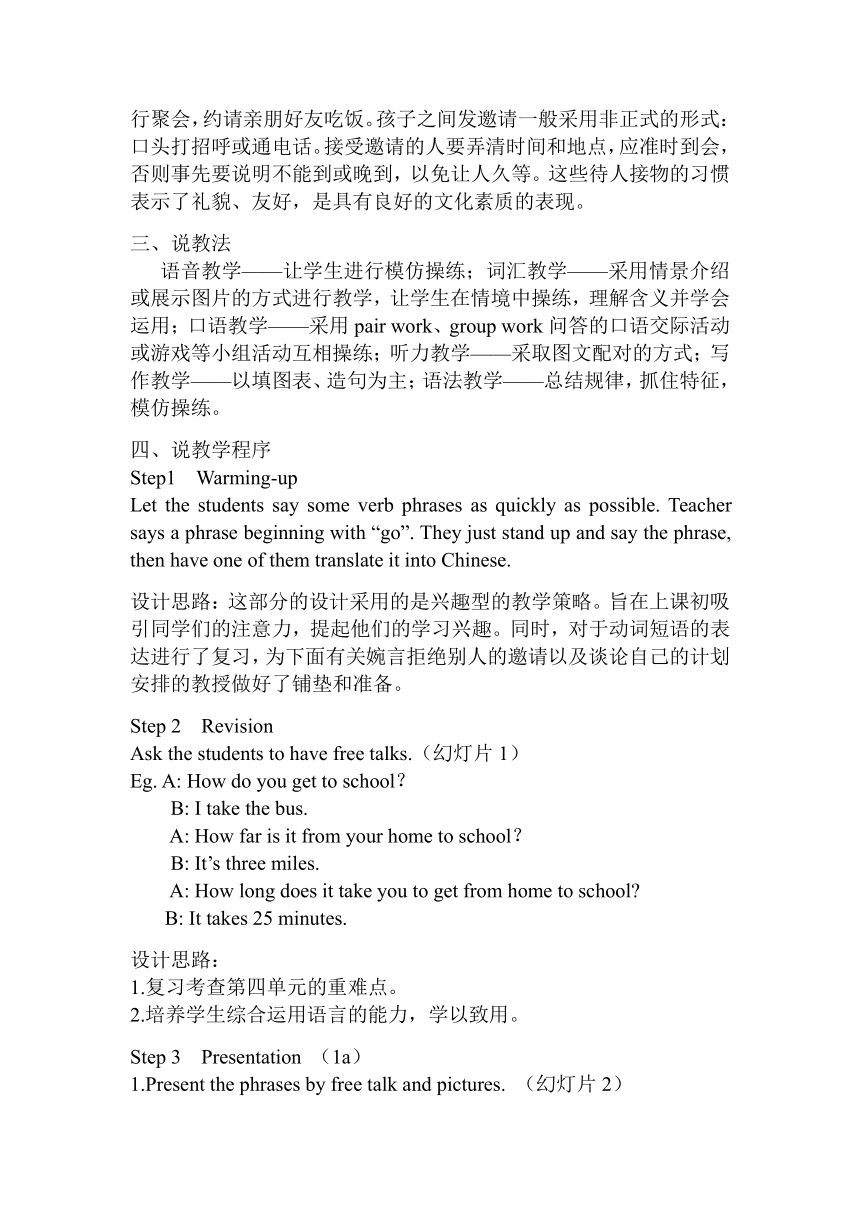八年级上英语|Unit 5 Can you come to my party?|Section A|1a-1c
文档属性
| 名称 | 八年级上英语|Unit 5 Can you come to my party?|Section A|1a-1c |  | |
| 格式 | rar | ||
| 文件大小 | 9.4KB | ||
| 资源类型 | 教案 | ||
| 版本资源 | 人教新目标(Go for it)版 | ||
| 科目 | 英语 | ||
| 更新时间 | 2009-12-13 20:51:00 | ||
图片预览


文档简介
新目标八年级上册Unit 5 Can you come to my party
The First Period Section A ( 1a, 1b, 1c ) 说课设计
云乡学校 钟伟雄
一、说教材
1、教材的地位及作用
本单元主要学习晚会的种类及形式的表达法,学会向别人提出邀请、接受或婉言拒绝别人的邀请,学会谈论自己的计划安排。本单元围绕“邀请和请求许可”这一话题,设计了三个任务型活动:
Task 1:对话展现提出邀请和接受邀请及拒绝邀请的英文表达。
Task 2:进行调查,询问同学们拒绝做某事的原因。
Task 3:制作请柬,练习对话,巩固所学单词及句型。
通过这三个任务型的活动使学生掌握提出邀请,接受邀请,拒绝邀请,并说明理由的表达方式。
2、教学目标
掌握有关邀请和请求许可的用语,拒绝邀请及合理的解释。
3、教学重点
(1)词汇:lesson
(2)语言结构:用Can…… 发出邀请。
用Sure, I’d love to. 接受邀请。用I’m sorry, I can’t. I have to ……拒绝邀请并说明理由。
(3)句型:Can you come to my party
Sure, I’d love to.
I’m sorry, I can’t. I have to ……
4、教学难点
使用Can…… 发出邀请。
使用I have to ……句型说明原因。
5、学情分析:
本单元的主题是发出邀请,接受邀请及拒绝邀请。围绕这一主题进行一系列交际活动,使学生熟练掌握以Can开头的一般疑问句并正确使用。 Sure, I’d love to./ I’m sorry, I can’t. I have to ……表示接受和拒绝邀请。在此之前,学生已掌握can,have to及would love的用法。所以,这些对学生来说并不难,比较容易掌握。
二、说教法
采用对话、表演、游戏、竞赛的学习策略,利用教学图片、幻灯片或制作课件等来展开课堂教学。本单元不仅仅教学有关邀请和请求许可的用语,还要让学生了解英语国家的风俗习惯,人们过生日常举行聚会,约请亲朋好友吃饭。孩子之间发邀请一般采用非正式的形式:口头打招呼或通电话。接受邀请的人要弄清时间和地点,应准时到会,否则事先要说明不能到或晚到,以免让人久等。这些待人接物的习惯表示了礼貌、友好,是具有良好的文化素质的表现。
三、说教法
语音教学——让学生进行模仿操练;词汇教学——采用情景介绍或展示图片的方式进行教学,让学生在情境中操练,理解含义并学会运用;口语教学——采用pair work、group work问答的口语交际活动或游戏等小组活动互相操练;听力教学——采取图文配对的方式;写作教学——以填图表、造句为主;语法教学——总结规律,抓住特征,模仿操练。
四、说教学程序
Step1 Warming-up
Let the students say some verb phrases as quickly as possible. Teacher says a phrase beginning with “go”. They just stand up and say the phrase, then have one of them translate it into Chinese.
设计思路:这部分的设计采用的是兴趣型的教学策略。旨在上课初吸引同学们的注意力,提起他们的学习兴趣。同时,对于动词短语的表达进行了复习,为下面有关婉言拒绝别人的邀请以及谈论自己的计划安排的教授做好了铺垫和准备。
Step 2 Revision
Ask the students to have free talks.(幻灯片1)
Eg. A: How do you get to school?
B: I take the bus.
A: How far is it from your home to school?
B: It’s three miles.
A: How long does it take you to get from home to school
B: It takes 25 minutes.
设计思路:
1.复习考查第四单元的重难点。
2.培养学生综合运用语言的能力,学以致用。
Step 3 Presentation (1a)
1.Present the phrases by free talk and pictures. (幻灯片2)
T: What are you doing this evening
S: I’m studying for a test.
Describe the phrases in 1a one by one. Have the students response the phrases according to the pictures.
设计思路:在这部分词组讲授中,通过由图片来展示,教师提问的方式,既复习了用现在进行时表将来,又学习了一些重点词组,使学生为后面的婉言拒绝别人邀请做好铺垫。
2.Match the words with the pictures.
1)Read after the teacher.
2) Students read, the teacher follows.
设计思路:考察,纠正学生的发言,同时给学生以成就感。
3. See “who has a good memory ” Show the picture for some seconds, then ask the students to match the words with the pictures.
设计思路:采用竞争的模式,调动同学们的兴趣。促使同学们对这部分内容做到进一步的掌握。
Step 4 Listening (1b)
1.Play the tape. Students listen and write the names next to the correct students in the pictures.
2.Play the tape again. This time students fill in the blanks.
3.Check the answers.
设计思路:1b部分为我们提供了一段录音材料,由于图片太明显,对学生的要求相对较低,我提高了要求,旨在培养学生听力和笔头方面的练习。
Step 5 Drill(1c)
1.Present the dialogue. Show a picture of my party.(幻灯片4) Say to the students “Tomorrow is my party. I’d like to invite some students to come to my party.”
Then ask students the question “Can you come to my party ” Have the students answer “Sure, I’d love to” or “Sorry, I can’t, I have a piano lesson.” and so on.
2. Practice the dialogue between teacher and students.
3. Work in groups. Group A ask and Group B answer.
4. Practice in pairs and act it out.
设计思路:这部分我采用了任务型的教学策略,在学生进行了反复的操练后,让他们思考 “Sure, I’d love to”及 “Sorry, I can’t. I have a piano lesson”的意义,并做出了归纳,锻炼了学生的思考能力,在接受任务,完成任务的过程中,获得成就感,对句型的掌握更为深入、透彻,从而突破了这个重难点。
5. Play a guessing game
Why can’t they come to the party
设计思路:
1.利用做游戏的形式让学生练习第二、三人称的转换。
2.适当引入竞争教学,使学生在激烈、快乐的竞争氛围中,巩固了重难点。
Step 6 Practice.
Make up similar dialogues .
设计思路:深化练习,巩固本节课所学的重点内容。
Step 7 Homework
Make a card with details of an event.
设计思路:巩固课堂上所学的知识,为下一节课作好准备。
板书设计:
Unit 5 Can you come to my party
Can you come to my party
Sure, I’d love to.
Sorry, I can’t. I have a piano lesson.
设计思路:根据本节课的重难点。
The First Period Section A ( 1a, 1b, 1c ) 说课设计
云乡学校 钟伟雄
一、说教材
1、教材的地位及作用
本单元主要学习晚会的种类及形式的表达法,学会向别人提出邀请、接受或婉言拒绝别人的邀请,学会谈论自己的计划安排。本单元围绕“邀请和请求许可”这一话题,设计了三个任务型活动:
Task 1:对话展现提出邀请和接受邀请及拒绝邀请的英文表达。
Task 2:进行调查,询问同学们拒绝做某事的原因。
Task 3:制作请柬,练习对话,巩固所学单词及句型。
通过这三个任务型的活动使学生掌握提出邀请,接受邀请,拒绝邀请,并说明理由的表达方式。
2、教学目标
掌握有关邀请和请求许可的用语,拒绝邀请及合理的解释。
3、教学重点
(1)词汇:lesson
(2)语言结构:用Can…… 发出邀请。
用Sure, I’d love to. 接受邀请。用I’m sorry, I can’t. I have to ……拒绝邀请并说明理由。
(3)句型:Can you come to my party
Sure, I’d love to.
I’m sorry, I can’t. I have to ……
4、教学难点
使用Can…… 发出邀请。
使用I have to ……句型说明原因。
5、学情分析:
本单元的主题是发出邀请,接受邀请及拒绝邀请。围绕这一主题进行一系列交际活动,使学生熟练掌握以Can开头的一般疑问句并正确使用。 Sure, I’d love to./ I’m sorry, I can’t. I have to ……表示接受和拒绝邀请。在此之前,学生已掌握can,have to及would love的用法。所以,这些对学生来说并不难,比较容易掌握。
二、说教法
采用对话、表演、游戏、竞赛的学习策略,利用教学图片、幻灯片或制作课件等来展开课堂教学。本单元不仅仅教学有关邀请和请求许可的用语,还要让学生了解英语国家的风俗习惯,人们过生日常举行聚会,约请亲朋好友吃饭。孩子之间发邀请一般采用非正式的形式:口头打招呼或通电话。接受邀请的人要弄清时间和地点,应准时到会,否则事先要说明不能到或晚到,以免让人久等。这些待人接物的习惯表示了礼貌、友好,是具有良好的文化素质的表现。
三、说教法
语音教学——让学生进行模仿操练;词汇教学——采用情景介绍或展示图片的方式进行教学,让学生在情境中操练,理解含义并学会运用;口语教学——采用pair work、group work问答的口语交际活动或游戏等小组活动互相操练;听力教学——采取图文配对的方式;写作教学——以填图表、造句为主;语法教学——总结规律,抓住特征,模仿操练。
四、说教学程序
Step1 Warming-up
Let the students say some verb phrases as quickly as possible. Teacher says a phrase beginning with “go”. They just stand up and say the phrase, then have one of them translate it into Chinese.
设计思路:这部分的设计采用的是兴趣型的教学策略。旨在上课初吸引同学们的注意力,提起他们的学习兴趣。同时,对于动词短语的表达进行了复习,为下面有关婉言拒绝别人的邀请以及谈论自己的计划安排的教授做好了铺垫和准备。
Step 2 Revision
Ask the students to have free talks.(幻灯片1)
Eg. A: How do you get to school?
B: I take the bus.
A: How far is it from your home to school?
B: It’s three miles.
A: How long does it take you to get from home to school
B: It takes 25 minutes.
设计思路:
1.复习考查第四单元的重难点。
2.培养学生综合运用语言的能力,学以致用。
Step 3 Presentation (1a)
1.Present the phrases by free talk and pictures. (幻灯片2)
T: What are you doing this evening
S: I’m studying for a test.
Describe the phrases in 1a one by one. Have the students response the phrases according to the pictures.
设计思路:在这部分词组讲授中,通过由图片来展示,教师提问的方式,既复习了用现在进行时表将来,又学习了一些重点词组,使学生为后面的婉言拒绝别人邀请做好铺垫。
2.Match the words with the pictures.
1)Read after the teacher.
2) Students read, the teacher follows.
设计思路:考察,纠正学生的发言,同时给学生以成就感。
3. See “who has a good memory ” Show the picture for some seconds, then ask the students to match the words with the pictures.
设计思路:采用竞争的模式,调动同学们的兴趣。促使同学们对这部分内容做到进一步的掌握。
Step 4 Listening (1b)
1.Play the tape. Students listen and write the names next to the correct students in the pictures.
2.Play the tape again. This time students fill in the blanks.
3.Check the answers.
设计思路:1b部分为我们提供了一段录音材料,由于图片太明显,对学生的要求相对较低,我提高了要求,旨在培养学生听力和笔头方面的练习。
Step 5 Drill(1c)
1.Present the dialogue. Show a picture of my party.(幻灯片4) Say to the students “Tomorrow is my party. I’d like to invite some students to come to my party.”
Then ask students the question “Can you come to my party ” Have the students answer “Sure, I’d love to” or “Sorry, I can’t, I have a piano lesson.” and so on.
2. Practice the dialogue between teacher and students.
3. Work in groups. Group A ask and Group B answer.
4. Practice in pairs and act it out.
设计思路:这部分我采用了任务型的教学策略,在学生进行了反复的操练后,让他们思考 “Sure, I’d love to”及 “Sorry, I can’t. I have a piano lesson”的意义,并做出了归纳,锻炼了学生的思考能力,在接受任务,完成任务的过程中,获得成就感,对句型的掌握更为深入、透彻,从而突破了这个重难点。
5. Play a guessing game
Why can’t they come to the party
设计思路:
1.利用做游戏的形式让学生练习第二、三人称的转换。
2.适当引入竞争教学,使学生在激烈、快乐的竞争氛围中,巩固了重难点。
Step 6 Practice.
Make up similar dialogues .
设计思路:深化练习,巩固本节课所学的重点内容。
Step 7 Homework
Make a card with details of an event.
设计思路:巩固课堂上所学的知识,为下一节课作好准备。
板书设计:
Unit 5 Can you come to my party
Can you come to my party
Sure, I’d love to.
Sorry, I can’t. I have a piano lesson.
设计思路:根据本节课的重难点。
同课章节目录
- Unit 1 Where did you go on vacation?
- Section A
- Section B
- Unit 2 How often do you exercise?
- Section A
- Section B
- Unit 3 I'm more outgoing than my sister.
- Section A
- Section B
- Unit 4 What's the best movie theater?
- Section A
- Section B
- Unit 5 Do you want to watch a game show?
- Section A
- Section B
- Unit 6 I'm going to study computer science.
- Section A
- Section B
- Unit 7 Will people have robots?
- Section A
- Section B
- Unit 8 How do you make a banana milk shake?
- Section A
- Section B
- Unit 9 Can you come to my party?
- Section A
- Section B
- Unit 10 If you go to the party, you'll have a grea
- Section A
- Section B
